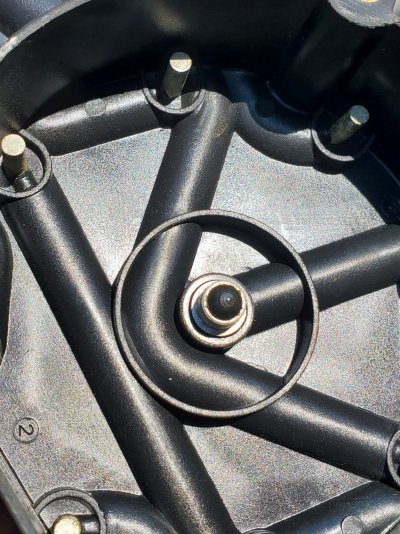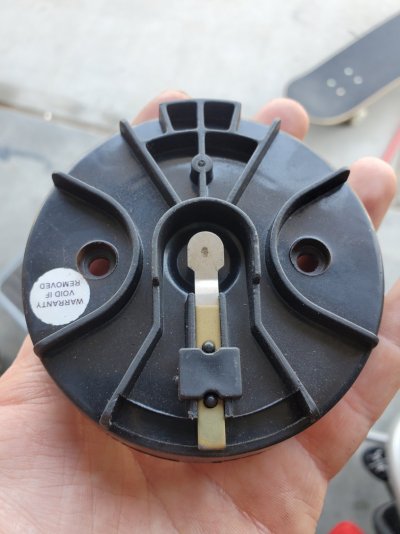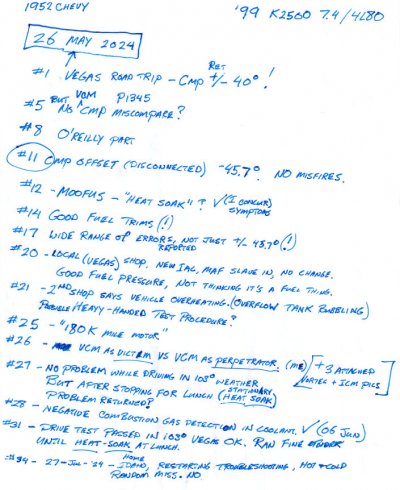Troubleshooting electronic-related Cold OK / Hot FAIL scenarios
For what it's worth I've reread this string from the beginning. In my next reply I'd like to dig a little deeper into
the reported full-scale swings in the CMP <> CKP comparison, while at the same time no DTC 1345 is flagged?
If the 'hot fail' symptoms re-occur, then here are some things to keep in the back of your troubleshooting mind.
(First stimulated during a road trip to southern Nevada -- see attached for my crib notes of this thread.)
Good for you that you were monitoring your VCM/engine bay while the error occurred. This way you
caught the CMP <> CKP sync value ("CMP offset") varying wildly between the limits at both ends while
the misfire was occurring. Given the rest of your reporting this feels like a electronic component that
has become thermal sensitive, especially given that if you let the vehicle cool off it will return to normal
operation.
Given that the CMP sensor has already been replaced (a good place to start) with no change in behavior,
we will need to decide whether the problem is on the ICM side or the VCM side of this circuit.
But before we get into specific troubleshooting, I'd like to discuss electronic thermal failures a bit more.
The first thing is that most electronic components are available that are spec'd to work at different temperature
ranges. And the ones that require the most research, verification, and testing to work reliably at temperature
extremes also (for obvious reasons) cost the most money.
So the delicate dance is for the design engineer to specify electronics that will work at the expected temperatures
plus a safety margin (headroom) so that the vehicle is reliable, whether deep in Alaska in the middle of winter, or
while traversing Death Valley in the heat of summer. But at the same time, as a good corporate citizen he
knows that he can't specify the use of ruggedized Mil-Spec or aerospace-quality electronics, for these parts
are much more expensive than the lower-tier stuff.
NOTE: In the price-sensitive aftermarket, in the race to the bottom all this nonsense about wide temp range
capable electronics sometimes takes a back seat to the goal of making the most attractively-priced ignition bits.
(And they use a longer warranty to overcome the 'you get what you pay for' customer expectation + cover the
scenario where a non-spec part is sold to the rare HD user who works the vehicle hard enough to precipitate
a stress failure. The corporate bet here is that the vehicle in question is parked at the lake cottage and used
gently/infrequently, -or- is sold before the part reaches a premature end of life from heavy use.)
Anyway, here's a little hand-drawn chart that attempts to show how we can end up with a tough thermal
intermittent buried in the ignition and/or control system for our powerplant that plays peek-a-boo with the owner:
You must be registered for see images attach
(I'm on the 3rd rewrite. I decided to replace several screens of blah blah blah with this hypothetical graphic. Hope it illustrates how some electronic parts that fade too early from
heat can lead to 'intermittent' behavior. (And why I used to fervently wish that electronics were purely good/completely broke like the old incandescent light bulbs of yore. :0)
Seriously, no matter what type of intermittency you are diagnosing, you really can't fix an intermittent sans parts cannon or vehicle trade in
until you first figure out how to break it at will. Simple as that.
Anyway, if the above causes any questions concerning electronic-related thermal intermittents I'll be happy to elucidate.
****
The remainder of this discussion will be based upon the first page of the P1345 DTC in the '99 FSM:
You must be registered for see images attach
(from the '99 FSM, Vol 3 & 4.pdf)
Alright. In the TBI era the all-important Reference Signal to the computer (aka 'RPM signal') came from the
distributor sensor as an analog signal to the 8-pin ICM, where it was converted to a Square wave, which was
forwarded to the ECU/PCM, which in turn enabled both spark & fuel injector pulses. Wicked important signal. :0)
EDIT: In the '96+ Vortec/VCM world, the VCM is the Master, and the ICM is simply the (coil) Blaster. The Vortec ICM is now
down to only 4 pins, all of which can be seen in the diagram above. (See attached for Vortec ICM pic.)
For those keeping score, the input from the C
KP (CranK Position) sensor is now the source of that all-important Reference signal.
Meanwhile, the sensor in the Vortec distributor is now only responsible to supply the CMP (CaM Position) signal that the VCM uses
to help identify where we are in the firing order, enabling SFI and accurate misfire error reporting.
Instead of attempting to turn us all into ignition system designers, for brevity I will instead just identify what
problems need solving, so that when they aren't solved we know which direction to head.
The first problem is that both the CKP & CMP sensors output an analog signal, which for timing purposes
needs to be converted into square waves. Here's a good illustration of what I'm talking about:
You must be registered for see images attach
(credit: thirdgen.org
Ignition signal discussion)
1) I bring this up because if the VCM circuitry heated up and lost the ability
to correctly trigger on the positive-to-negative zero crossing, then you
could easily get those wild CMP offset readings. (If you happen to be a
scope dope it's easy to visualize what a loss of trigger sync does.)
* First possibility identified: circuitry involved in signal conversion heats up
and we lose sync with the engine rotation. All other VCM functionality
is unaffected. But why wouldn't this flaky Reference signal not create a
miscompare triggering a P1345 DTC & SES light?
Troubleshooting hint: If the failure is CMP related, the CMP offset is
goofed up, but the engine still runs right/close to right. (VCM reverts
to Batch fire, and also can no longer discern which cylinder is misfiring.
Maybe error reporting degrades to P0300?)
On the other hand, if the CKP is the affected signal, you will experience
noticeable roughness, for everything is timed off of the CKP 'Reference'
signal. (!)
2) Input power to CKP, ICM, and Ignition Coil (circuit #439) is flaky. IF
the coil were to heat up and this was to cause the secondary to arc
back into the primary (+12v power circuit) ...this could create havoc
downstream with the CKP sensor. How old is your coil? Any signs of
distress? Will it pass the fine mist test?
* Second possibility identified: Flaky high voltage coil causing CKP
reference signal disruption via shared +12v circuit? But why wouldn't
this flaky Reference signal not create a miscompare triggering a
P1345 DTC & SES light?
3) ICM heats up and loses ability to properly drive Ignition Coil.
But how does this cause flaky CMP offset readings? (Unless normal
flyback from coil primary is coupled back to weakened ICM, and now
RFI is in turn coupled back to the VCM?
Third possibility: ICM heats up, loses high voltage gatekeeper functionality,
and is polluting the VCM with coil-generated RFI.
****
And although I've been trying to avoid going here, when all else is proven
good, then we have no choice but to consider the VCM as the root cause
of the failure. The fact that VCM hasn't been kicking a P1345 despite you
seeing wild CKP<>CMP sync swings all the way to +/- 40° is a concern.
Is the VCM no longer capable of kicking DTCs and lighting the SES light?
What happens if you disconnect the MAF? (The engine should continue to
run on the MAP and also kick the SES light and log a P010x DTC? If the
DTC is kicked, can you shut the engine off, wait 10-15 seconds, restart
the vehicle, and the DTC isn't lost across the power cycle? How about
a P1345 if you were to misadjust the distributor assy ~15°?
I could continue, but I think this is a good stopping point for this evening.
Some parts have been changed, including the CMP sensor on the new(er)
distributor, which was a good starting point. IF the hot fail were to return,
then we need to try to figure out if the VCM is the victim of a bad input,
a hot coil flaking out and throwing lightning bolts back into it's coworkers,
or a previously overlooked failure in the power or ground circuits?
Or is the aging VCM heating up and flaking on us, mishandling good
input signals while not telling on itself with 1 or more DTCs?
****
Anyone still reading this who has an anecdotal story about a similar failure
and eventual fix please share it here.
And circling back to an earlier comment I made earlier, IF you can figure
out how to make the heat fail occur at will, then maybe we could also
figure out a temporary work-around to confirm our diagnosis?
(Only fails during extended heat soak with hood down. But always
starts when hood is popped at every stop?) Or a bag of ice on the VCM
shortens the wait/fixes the issue every time?
Sincere apologies for the length. Paraphrasing Mr. Hendrix,
'ther-mal mal-func-tions is a fru-stra-ting mess'
:0)
As always, thanks for the detailed status reports, and please
continue to keep us in the loop on this.
Every trip a round trip!
Cheers --





